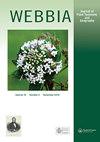Diversity and distributional patterns of aroids (Alismatales: Araceae) along an elevational gradient in Darién, Panama
Q3 Agricultural and Biological Sciences
引用次数: 9
Abstract
ABSTRACT The family Araceae (aroids) represents an ecologically important and diverse group of plants in Panama, represented by 25 genera, 615 species, of which 277 (45%) are considered endemic. The aim of this study is to analyse the diversity and distributional patterns of aroids along an elevation gradient in the species-rich forests of Darién, Panama. We confined our study to three study sites, selected across gradients of elevation (ranges): 100–300, 500–700 and 1100–1300 m. We recorded 3187 specimens, of which 397 were terrestrials, 637 epiphytes and 2153 nomadic vines, distributed in 10 genera and 61 species. Our study shows that the most diverse areas were those between 500 and 700 m and the highest abundance were measured at 1100–1300 m. The epiphytic aroids displayed greater species richness and abundance at 1100–1300 m; the nomadic vines had greater richness between 500 and 700 m and greater abundance from 100 to 300 m. Similarly, terrestrial aroids showed greater richness at 500–700 m, and exhibited abundance values similar to that of the epiphytes. We measured a high degree of aroid species turnover along the elevation gradient and some genera and species (many being endemic) appeared strongly associated with sites at specific elevations.巴拿马Darién海拔梯度上aroids(Alimatales:Araceae)的多样性和分布模式
天南星科(aroids)是巴拿马一个重要的生态多样性植物群,共有25属615种,其中277种(45%)为巴拿马特有植物。本研究的目的是分析在巴拿马达里萨芬物种丰富的森林中沿海拔梯度的树的多样性和分布模式。我们将研究限制在三个研究地点,选择海拔梯度(范围):100-300米,500-700米和1100-1300米。共记录标本3187份,其中陆生植物397份,附生植物637份,游牧藤本植物2153份,分布于10属61种。研究表明,在海拔500 ~ 700 m的区域,植物多样性最强,在海拔1100 ~ 1300 m的区域丰度最高。1100 ~ 1300 m处附生藜的物种丰富度和丰度较高;游牧葡萄树在500 ~ 700 m之间丰度更高,在100 ~ 300 m之间丰度更高。500 ~ 700 m的陆生植物丰富度与附生植物相似。在海拔梯度上,我们测量到了高度的回避物种更替,一些属和种(许多是特有的)与特定海拔的地点密切相关。
本文章由计算机程序翻译,如有差异,请以英文原文为准。
求助全文
约1分钟内获得全文
求助全文

 求助内容:
求助内容: 应助结果提醒方式:
应助结果提醒方式:


